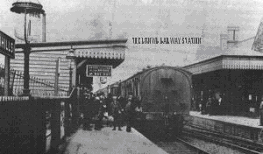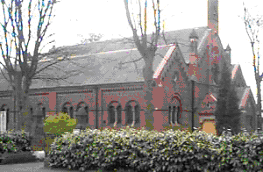
JOHN ROBINSON McCLEAN 1813(?) - 1873
John Robison McClean was born in Belfast in 1813. He was educated at Glasgow University and while he was there he studied, Natural Philosophy, Surveying and importantly to Brownhills, Mining Engineering. He was a remarkable man who had great vision, in the field of Mining and Railways. His achievements in and around the Brownhills area were equal to those of, ‘Isambard Kingdom Brunnel’ and ‘Thomas Telford’.
John McClean became involved in the initial stages of the development of the railway line between Walsall and Lichfield. He was appointed by the Company as, Chief Engineer. The Railway, which became known as ,’The South Staffordshire Railway, passed through Brownhills and so when it opened in 1849, Brownhills had a new transport system that allowed its coal to be moved out to other areas, very cheaply, also it helped bring in labour and shoppers for the High Street.
John McClean could instantly see the potential of the Railway and after 1 year he took over the Railway on a 25 year lease and after an Act of Parliament became the first person in history to be the sole owner of his own railway.

Another of John Robinson McClean brilliant ideas, which also happened to make him a lot of money was a project under taken by, ‘The South Staffordshire Waterworks’. The idea which was thought of by McClean was fresh drinking water for the Black Country.
In the early to mid 1800’s the Sanitary conditions in towns were at best appalling and at worst infested with the deadly infectious disease, ‘Cholera’. Drinking water was contaminated with sewage and toxic wastes. As a consequence as the towns became more populated conditions got worse and so people took to drinking, Canal water and stagnant water from pools. As conditions deteriorated as the century moved on in 1848/49 a massive Cholera epidemic struck most families in the area. The same conditions were being experienced all over the Country, and several bills were put before Parliament and various schemes recommended to try to improve conditions.
In 1852 a Dudley mine owner and Industrialist named, ‘Samuel Holden Blackwell’, put before Parliament a Bill, to supply water to the Black Country, He called it, ‘ The South Staffordshire Mining District Water Company Bill’. Parliament rejected the Bill on the grounds that the proposed supply of water, namely a brook which was a tributary of the River Stour, was polluted with Raw Sewage. Not such a good idea!
Who made a timely entrance to the scene, John Robinson McClean. He had had a similar idea 12 months earlier but proposed using the River Trent as a source for his water supply. He could not get enough support and financial backing at the time and so gave up on the idea. John McClean approached Samuel Blackwell with his ideas and both persuaded several business men to back them, hence , ‘The South Staffordshire Water Works Company’ was formed.
John McClean with his surveying knowledge and a sound understanding of the resources in the area, because he had leased most of them over the previous years, proposed using water from the streams and pools in and around Lichfield as these were fresh and unpolluted by Industry. He also came up with pumping the water through pipes to the Black Country using the route of his South Staffordshire Railway. This was a brilliant, cost effective scheme, which could also earn J.R.M a nice bit of extra revenue from rent for using his land. The Bill was put before Parliament in 1853 and within 6 months was given Royal Assent. McClean eventually offered to lease the Company, which had completed the task of supplying water as far as Walsall, His offer was excepted and after more investment fresh water was piped to all the Black Country. The Idea of John McClean must have been a good one as the same system was used for over a hundred years before a alternative source was used.
There can still to be seen, pieces of broken cast iron pipes along the old disused railway track, as the old pipes were dug up in 1987 and remnants left behind.
A further example of John McClean involvement in the area is St.
Anna’s Church in Chasetown.

John commissioned the Church to be designed by, ‘Edward Adams’,
an eminent architect from London. John McClean was the founder of the Church
which he had built in 1865 and the entire building was paid for
out of his own funds. The Cannock Chase Colliery Co. also paid
for the vicar which allowed all the seats in the Church to be free, which was
most unusual in those days. Chasetown became John McClean's
little "Company Town", Schools were built and maintained and an
Institute containing a Library and Leisure facilities was built by the Company.
These facilities along with a wide range of shops and other services, such has a
Doctors made Chasetown the envy of the surrounding villages. This way of helping
his workforce meant that John McClean attracted some of the best Miners in the
area. In 1881 the population of Chasetown was 2,173
comprising of 430 Households; over half of these were mining
households.
A further building which he had Edward Adams design, was
Brownhills Station, which stood by Brownhills Bridge, for 100
years, on the South Staffordshire Railway Line. The approach to
the old station was from the Lichfield Road.
A Bust of John McClean and a commemorative plaque can be seen
in St Anne’s Church.
A further venture undertaken by John McClean was into Coal Mining, he must have been a very busy man. In 1853, The Marquis of Anglesey, Henry William Paget, advertised for letting, 2 pits and untapped mines on the Cannock Chase. The 2 pits which were working were, The Hammerwich Pit, which was close to, the Norton Reservoir and The Uxbridge Pit in Chasetown.
John McClean and a partner called, ’Richard Croft Chawner’, who came from Hammerwich, agreed terms for leasing the pits in 1854. Although the Marquis died before the agreement was finally signed, the two men took control of the two pits and eventually agreed new terms with the new Marquis. The two men called their new Company, ‘The Cannock Chase Colliery Company’. They named the Hammerwich pit, No 1 Pit and the Uxbridge became the No2 Pit or, ‘The Fly Pit’, as it became known locally. The Company soon expanded and eventually opened 10 Pits in the area. The Company transported the coal by barge loading it at a wharf on the Anglesey branch of the canal, close to Chasewater reservoir. They also built a railway system which went from Pit head to Pit head collecting the coal and taking it to the canal wharf. John McClean who remember had the South Staffordshire Railway Line no more than 1 mile from their enclosed railway. He eventually in 1858 connected his internal railway to the S.S.R at Newtown Bridge in Brownhills, these became known as,’ The Anglesey Sidings’. This branch line was still in use 100 years later, until it was closed and removed in 1966.
McClean brought a locomotive to work pulling his trucks of coal, he called it, ‘McClean’, it was built in Manchester by, Beyer and Peacock. 5 years later in 1861 another loco, the same as the first was purchased and this was called ’Chawner’ after his partner.
John Robinson McClean died in 1873 at the age of 60. He had become a most highly respected engineer and his advice was asked for on many occasions. He was the main Engineer of the Plymouth and Dover Harbours; he advised on the building of the Suez Canal and became Chairman of, The Anglo-American Telegraph Company. The people of Brownhills can only be thankful he chose to spend his life developing the Industries and so the prosperity of the area. He was truly a great man.